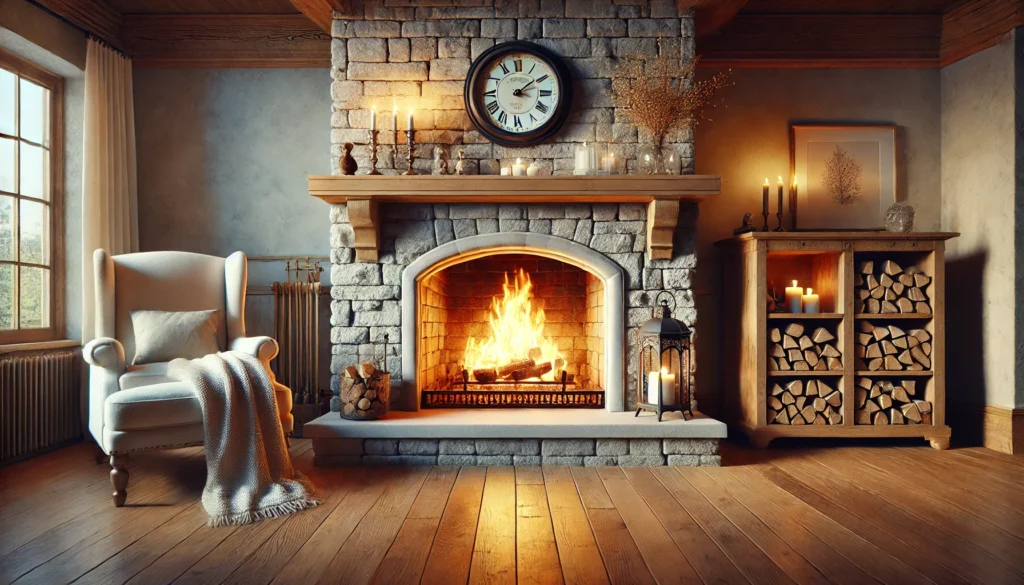
Few things create a warm and inviting atmosphere like a crackling wood-burning fireplace. Whether you’re considering buying a home with one or already own a house with a traditional fireplace, you may wonder: Are wood-burning fireplaces efficient?
As a home inspector, I get this question a lot from buyers who love the idea of a fireplace but are concerned about energy efficiency, safety, and maintenance. Let’s take a closer look at the pros and cons of wood-burning fireplaces and explore alternative heating options that might better suit your home.
How Efficient Are Wood-Burning Fireplaces?
Traditional wood-burning fireplaces look great, but they are not an efficient way to heat your home. In fact, much of the heat they generate escapes up the chimney, pulling warm air out of your home rather than keeping it inside. Studies show that some open fireplaces can actually have negative efficiency, meaning they remove more heat from the home than they produce!
If you’re looking for a reliable heat source, a traditional fireplace alone won’t cut it—especially in cold climates. However, there are ways to improve efficiency, which we’ll discuss later.
Common Concerns with Wood-Burning Fireplaces
Before you commit to a wood-burning fireplace, there are a few factors to consider:
1. Energy Efficiency
Because fireplaces pull warm air up the chimney, they create drafts that force your heating system to work harder. While sitting close to the fire feels warm, the overall efficiency is low compared to other heating options.
2. Maintenance and Upkeep
Wood-burning fireplaces require regular cleaning to prevent creosote buildup, which can cause chimney fires. Homeowners must:
- Clean out ashes after each use
- Have the chimney professionally inspected and swept at least once a year
- Store and properly season firewood to prevent excessive smoke
3. Air Quality and Safety Risks
Burning wood produces smoke and fine particulate matter, which can negatively impact indoor air quality. Improper ventilation can also lead to carbon monoxide buildup—a serious health hazard.
Additionally, sparks and embers can pose a fire risk if not properly contained with a screen or glass doors.
Alternatives to Traditional Fireplaces
If you love the ambiance of a fireplace but want better efficiency and safety, consider these alternatives:
1. Wood-Burning Fireplace Inserts
A wood-burning insert fits inside your existing fireplace and significantly improves efficiency. These inserts are designed to burn wood more completely, reducing heat loss while keeping your home warmer.
2. Gas Fireplaces
A gas fireplace provides steady heat at the push of a button—no chopping, stacking, or hauling wood required. They offer:
✔ Higher energy efficiency
✔ Lower maintenance
✔ Consistent, adjustable heat output
Many modern gas fireplaces look just like real wood-burning fireplaces, with ceramic logs that simulate the appearance of burning wood.
3. Electric Fireplaces
Electric fireplaces are the easiest to install and maintain, making them a great option for homeowners who want ambiance without the hassle. They require no venting, are energy-efficient, and can be installed almost anywhere in the home.
Should You Buy a Home with a Wood-Burning Fireplace?
If you’re in the market for a home with a fireplace, it’s important to include a fireplace and chimney inspection as part of your home inspection. A professional inspector will check for:
✅ Creosote buildup
✅ Structural integrity of the chimney and flue
✅ Proper ventilation and damper function
✅ Signs of water damage or leaks
A neglected chimney can lead to costly repairs and even become a fire hazard, so be sure to get it checked before finalizing your home purchase.
Final Thoughts
Wood-burning fireplaces add charm and character to a home, but they are not the most efficient heating solution. If you love the tradition of burning wood, consider adding an insert to improve efficiency and reduce heat loss. For homeowners looking for low-maintenance, cost-effective alternatives, gas or electric fireplaces offer warmth, ambiance, and convenience.
Ready to Schedule Your Edmonton Home Inspection?
Call Us or Book Online—we’re here to help you make a confident, informed decision.
Click here to learn more about home inspection issues in Edmonton, St. Albert, Spruce Grove, Leduc, Sherwood Park, Fort Saskatchewan and surrounding areas. If you’re buying, selling, or renovating, we’ll give you the clarity you need to protect your investment.



